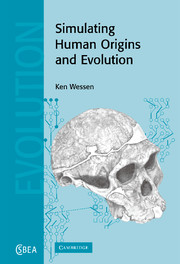13 - Discussion
Published online by Cambridge University Press: 14 August 2009
Summary
The impact of the basic parameters of population size limits, breeding patterns, sex ratio, chance of reproduction and expected number of offspring, as well as some population-wide external influences on a single, unstructured population, was studied in the simulations presented in Chapter 10. In Chapter 11, these results were extended to include migration, and in Chapter 12, selective advantage. In all cases, the simulation results were analysed with respect to both one-parent and two-parent ancestry.
These results are summarised in the following sections, after which there is a brief discussion of their implications for understanding the origin and evolution of modern humans. Finally, the direction of some ongoing and proposed future simulation development is discussed.
Single-population summary
Constant demographics
The initial simulations studied involved a purely monogamous population, where all individuals were able to mate and fertility was such that a constant population was easily maintained (for a given population limit of 200 individuals). Increases in fertility beyond this level had no effect on the genealogy, and the results matched the theoretical expectations from coalescent theory for the time back to the most recent paternal and maternal common ancestors (Kingman, 1982a,b; Hudson, 1990).
- Type
- Chapter
- Information
- Simulating Human Origins and Evolution , pp. 220 - 230Publisher: Cambridge University PressPrint publication year: 2005



